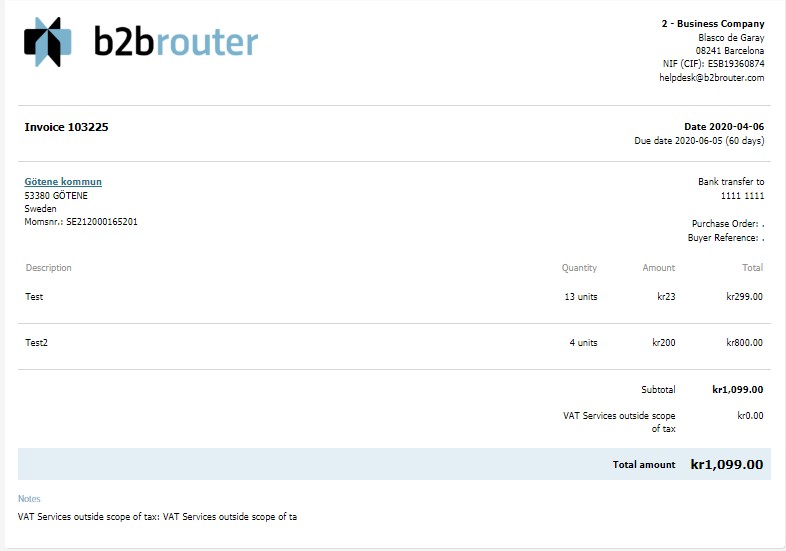
Do you know that VAT and other data are necessary to send invoices for the EU?
Invoicing crossborder goods or services to an EU company can be a challenge due to the specificities of this type of transaction. Although each EU country may have its own specificities or regulations, you should take into account certain aspects. Some examples would be the taxes to be applied on the invoices, mandatory data, vat invoice format or specific invoice format.
Value added tax (VAT)
The tax applied in the EU for commercial transactions is the Value Added Tax (VAT). This is a tax imposed on the purchase of goods or services. As a general rule, it must be applied to the taxable amount of each invoice issued between companies or professionals of each country.
Each country has different rules regarding the VAT rate or the VAT invoice format to be applied for each transaction. In addition, this percentage depends on the type of product or service, whether they are essential goods or not, for example. It also varies if it is a B2B (Business to Business) or B2C (Business to Customer) transaction.
International transactions
If your company is not from the EU and you need to invoice a service or product to an EU company, you need to correctly apply the taxes in order to comply with the regulations of your country. In these cases, a mechanism called reverse charge is generally applied. This means that as an invoice issuer to a company in another EU country, you are exempt from charging VAT. As a result, the recipient is responsible for declaring the VAT for the transaction, according to the regulations of the country in which he or she is located.
Keep in mind that this is a general situation, but there can be instances where you have to act differently. If you have doubts about your specific case, you should contact your counsellor.
How to inform the VAT tax on your invoices?
Although in the case of issuing an invoice to a company in another country you are exempt from paying taxes, it does not mean that you are exempt from informing the tax on the invoice. Consequently, when you generate the invoice you must apply an Exempt VAT or similar and 0% tax rate. In addition, you must specify the reason why you are exempt from paying the tax. An example of exemption is: VAT Services outside scope of tax, Exempt, etc.
We provide you with an example of an electronic invoice created from our online electronic invoice generator, with the specifications mentioned above:

Other compulsory data:
There are other compulsory details that you must provide in the crossborder invoices in order to be considered correct:
- Invoice issue date.
- Invoice number.
- Invoicing issuer identifier (VAT or other type of identifiers).
- Invoicing receiver identifier (VAT or other type of identifiers).
- Name and address of the issuer.
- Name and address of the receiver.
- Description and quantity of the invoiced goods or services.
- Price per unit of the invoiced goods or services (without taxes).
- The VAT type to be applied on the invoice.
- The amount of VAT to be paid on the invoice
- Breakdown of VAT to be paid or exemption of VAT.
- In the case of invoicing in a different currency than the currency of the receiver, you must indicate the exchange rate of this currency with the one you are using for the invoice.
Other important information
In addition to correctly introducing the VAT and other mandatory data in the invoice, there are other things you should know if you need to invoice to the European Union or to countries different from your company:
Do you know how long you need to store the invoices?
You should take into account two aspects about the storage of the invoices:
First of all, you do not need to comply with the regulations of the country you are sending the invoice to. Therefore, you need to store the invoices as long your country regulations require.
In addition, you need to store the invoices in the same format in which you have sent them. For example, if you have issued a paper invoice, you must store a paper version. In the case you have issued an electronic invoice, you must store it in the same format as you have sent it and digitally.
European electronic invoicing
Many countries in the European Union are introducing electronic invoicing. In some cases, the law requires invoices to be electronically issued in order to be sent to the public administration. In other cases, a private company may manage its invoicing through an electronic document exchange network and request that you send them an electronic invoice. You should bear in mind that there are different formats and networks to send the invoice, which may vary depending on the receiver or the country.
Consequently, you must adapt to the law and issue electronic invoices in the cases in which it is compulsory. You can contact us if you have any doubts about the e-invoice regulations of the country you need to send an electronic invoice to.
Invoice languaje
There is no specific regulation regarding the invoice language. Therefore, you can issue invoices both in your language and in your customer’s language. An interesting solution is to create invoices using an application that facilitates the management in both languages. B2Brouter is a free invoice generator that allows you to create electronic invoices in your own language, keep them and manage them in your language, but send them in the receiver’s language.
As you can see, there are several aspects that you need to take into account when sending invoices to other countries. B2Brouter is an online invoice generator that helps you to decrease the difficulty of these operations and allows you to manage all your einvoicing, issued and received, at national and international level.
Sign up for free and start einvoicing now!